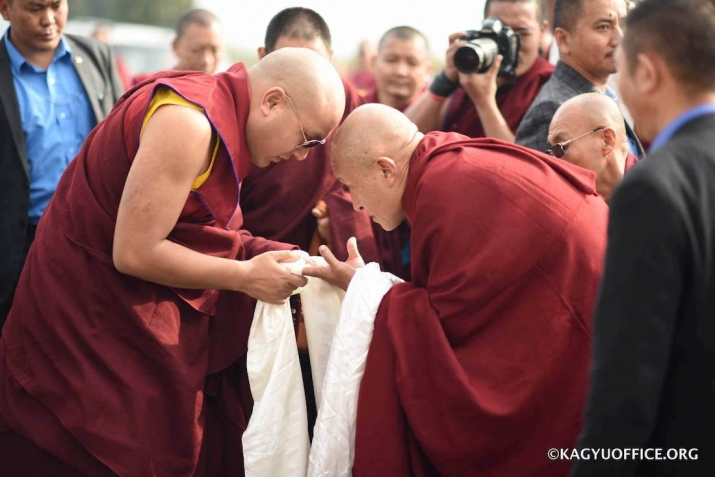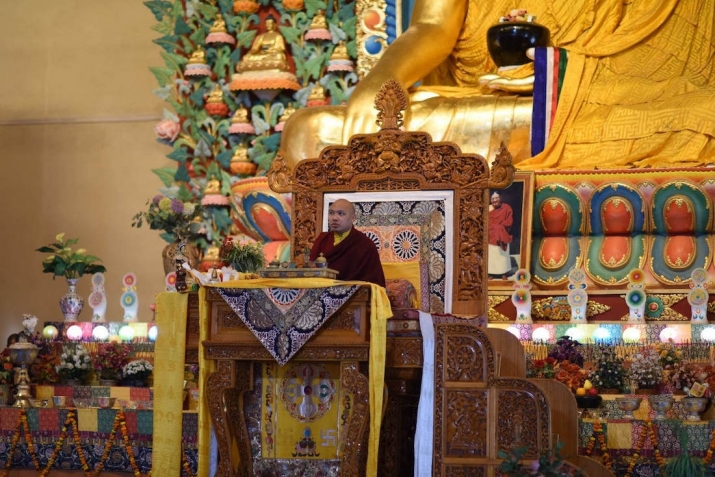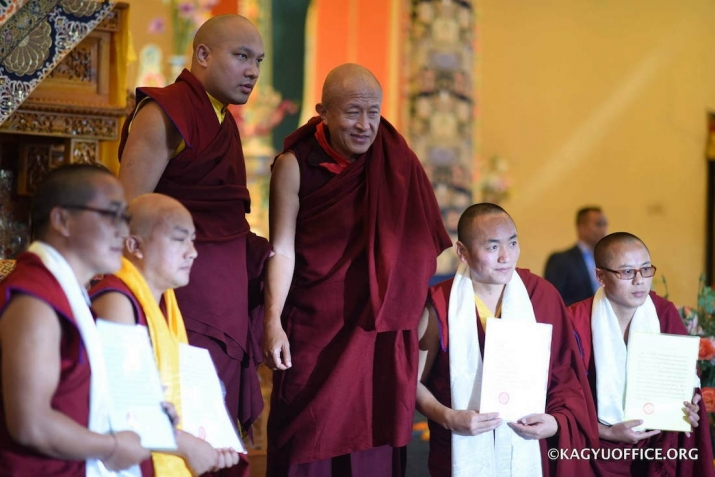NEWS
His Holiness the Karmapa Awards Khenpo Degrees at Dzongsar Institute
 Dzongsar Khyentse Rinpoche, right, greets His Holiness the Karmapa. From kagyuoffice.org
Dzongsar Khyentse Rinpoche, right, greets His Holiness the Karmapa. From kagyuoffice.orgRenowned Bhutanese lama, filmmaker, and writer Dzongsar Jamyang Khyentse Rinpoche recently underlined the close relationship between the Karmapa and Khyentse lineages by inviting His Holiness the 17th Karmapa, Ogyen Trinley Dorje, to award diplomas to four new khenpos* at the Dzongsar Khyentse Chökyi Lodrö Institute, a shedra (monastic collage) founded by Rinpoche in Himachal Pradesh, northern India.
Born in Bhutan in 1961 and now based in Himachal Pradesh, Dzongsar Khyentse Rinpoche is the son of Thinley Norbu Rinpoche and was a student of Dilgo Khyentse Rinpoche. He is recognized as the third incarnation of Jamyang Khyentse Wangpo, the founder of the Khyentse lineage. His projects include the Khyentse Foundation, which provides the financial support to fulfill his aspirations; 84000, which oversees the translation of the Word of the Buddha into modern languages; Lotus Outreach, which directs a wide range of projects to help refugees; and most recently The Lhomon Society, which promotes sustainable development in Bhutan through education.
After Dzongsar Khyentse Rinpoche made the traditional mandala offerings to mark the beginning of the ceremony, His Holiness the Karmapa addressed the assembled monastics on the special ties between the Karmapa and the Khyentse lineages and the importance of monastic education.
 The Karmapa addresses the assembled monastics at the Dzongsar Khyentse Chökyi Lodrö Institute. From kagyuoffice.org
The Karmapa addresses the assembled monastics at the Dzongsar Khyentse Chökyi Lodrö Institute. From kagyuoffice.org“When I was still in Tibet, of all the collected works I read, the one I looked at the most was that of the first Khyentse, Jamyang Khyentse Wangpo (Pema Ösel Dongak Lingpa, [1820–92]). I read it cover to cover and returned to it many times,” His Holiness recalled, noting that Khyentse Wangpo was truly Rimé (nonsectarian). “These days saying ‘Rimé’ sounds good, but often it is just ornamental, merely for show. To be a true master of these teachings is not at all easy. Many people are said to be experts, but if you look through history for a master of the teachings, you will find that Jamyang Khyentse Wangpo was an authentic one.” (Karmapa)
Speaking warmly of the relationship between Jamgon Kongtrul Lodro Thaye and Jamyang Khyentse Wangpo (1813–99), who together founded the Rimé movement, the Karmapa continued: “In the predictions of the 5th Karmapa Deshin Shekpa [1384–1415], the coming of the Khyentse and Kongtrul incarnations was foretold, and Deshin Shekpa also prophesized that whoever made a connection with them would find it deeply meaningful.” (Karmapa)
His Holiness praised Dzongsar Khyentse Rinpoche’s approach to teaching, which he described as “unambiguous, straightforward, penetrating, practical, and touching the heart,” remarking: “I have true devotion and pure vision for this lineage. I am very happy that I could meet Khyapje Dzongsar Khyentse Rinpoche here at his seat with all the khenpos and students, and that I could be present with everyone in a single mandala.” (Karmapa)
On the subject of monastic academic achievements, the Karmapa noted that it was important to maintain Tibetan traditions within the context of the 21st century: “Tibetans should not just follow their own tradition, but also look into the way things are done in this present age. In particular, we should pay attention to how education is given and include history in our curriculum,” he stated. “For example, we might study [Chandrakirti’s] Entering the Middle Way for a year, but if asked who translated this root text into Tibetan, we cannot answer because we have not looked into the historical background. This needs to change.
“If we know about the generations stretching into the distant past, when we are looking at a text, a different perspective and feeling can happen,” His Holiness said. “On the other hand, if we are not aware of the history and look straight off at the text, we will not know about the scholars who wrote it, or when and where they lived. We will just know their name, but not the relationships they had with other masters and what their life’s situation was. Without this knowledge, our understanding of a text is not complete,” he said. (Karmapa)
In his concluding remarks, the Karmapa observed that in continuing the Rimé tradition of the Khyentse lineage, the Dzongsar Khyentse Chökyi Lodrö Institute welcomed students from all traditions. His Holiness prayed for the minds of all the students to be in harmony, their discipline pure, and that they dedicate their time to the study and practice of the Dharma.
 The Karmapa and Dzongsar Khyentse Rinpoche with the new khenpo degree holders. From kagyuoffice.org
The Karmapa and Dzongsar Khyentse Rinpoche with the new khenpo degree holders. From kagyuoffice.orgThe institution of the Karmapa is the oldest tulku lineage in Tibetan Buddhism, dating back to the first Gyalwa Karmapa, Düsum Khyenpa (1110–93), and predating the Dalai Lama lineage by more than two centuries. The movements of His Holiness, who is based in the town of Sidhbari in Dharamsala after fleeing Tibet at the age of 14, remain closely watched by the Indian government.
Deep Connections between the Karmapa and Khyentse Lineages: The Gyalwang Karmapa Awards Khenpo Certificates at Dzongsar Khyentse Chökyi Lodrö Institute (The 17th Karmapa: Ogyen Trinley Dorje)
The Activities of Dzongsar Jamyang Khyentse Rinpoche
Traditional Learning and Practice Centers (Siddhartha’s Intent)
Dzongsar Khyentse Rinpoche Urges “Radical” Reform of Tulku Training in the Vajrayana Tradition
Dzongsar Khyentse Rinpoche’s Fourth Film Debuts in Switzerland
Sikkim Residents Request Indian Government to Allow Karmapa to Visit Rumtek Monastery
Dzongsar Khyentse Rinpoche Concludes Rinchen Terdzö Empowerments in Bhutan
Karmapa Arrives in Switzerland on Third Official Visit to Europe
His Holiness the Karmapa Trains Buddhist Monastics in Disaster Management
His Holiness the Karmapa Hosts Free Medical Camp for the Disabled in Bodh Gaya
His Holiness the Karmapa Launches Digital Jiang Kangyur
His Holiness the 17th Karmapa to Empower Female Buddhists with Monastic College














